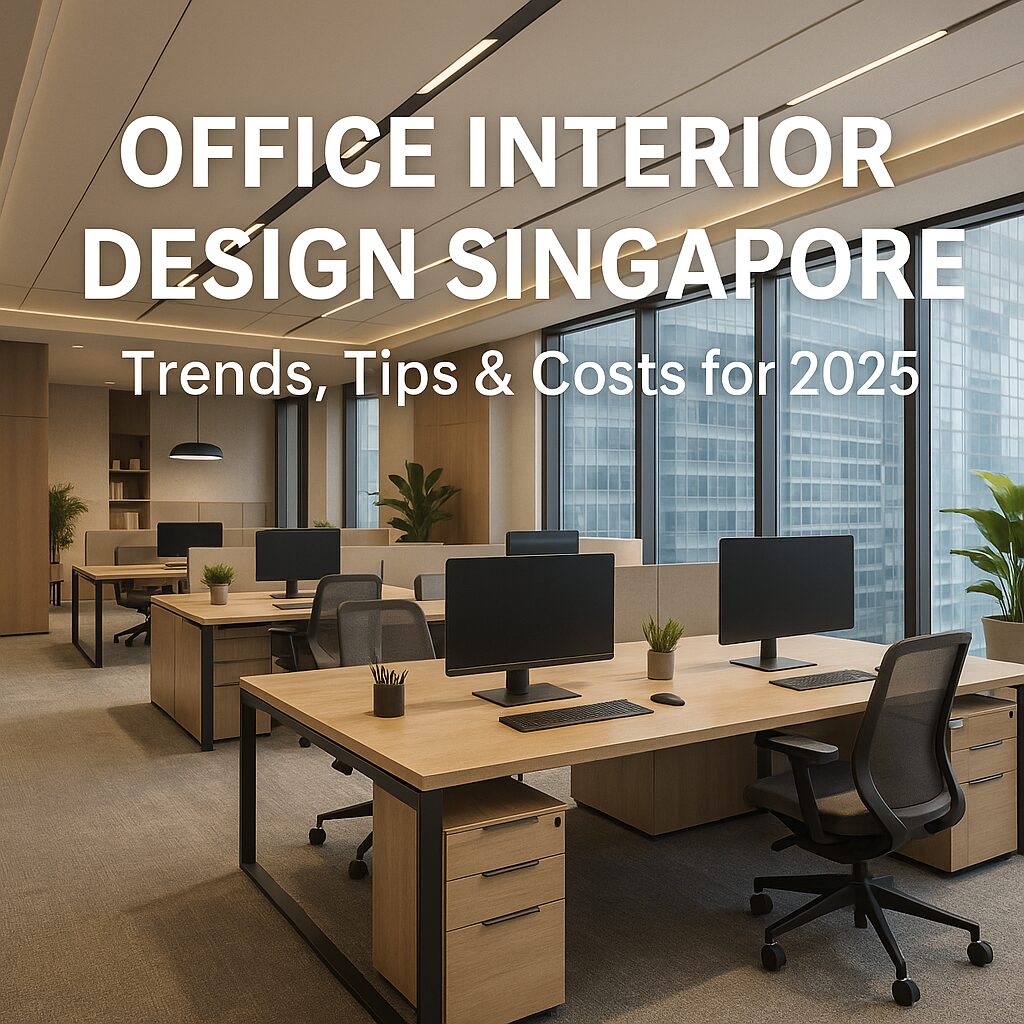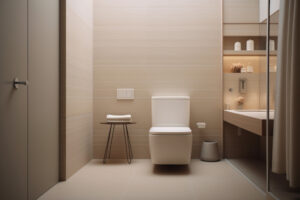Table of Contents
What Makes a Great Office Design in Singapore Today?
Gone are the days when offices were just rows of desks and white walls. In 2025, the best workspaces in Singapore are built around how people actually work—collaboratively, flexibly, and often, a little remotely.
A great office design balances function with feeling. It helps your team focus when they need to, brainstorm when ideas are flowing, and unwind when it’s time to take a break. It’s also one of the most overlooked ways to boost morale and retain good people.
In Singapore, where space is tight and rent isn’t cheap, it also makes financial sense. Smart layouts, built-in storage, and flexible zones help businesses get more out of every square foot—without having to expand.
Popular Office Interior Design Trends in Singapore (2025)
Let’s kickstart with the latest office design trends.
Office spaces in Singapore are evolving fast—partly because of hybrid work, but also because employees expect more than just a desk and chair. Here are the trends we’re seeing in 2025 that are shaping how companies design their spaces:
1. Biophilic Design
This trend has taken root—literally. More offices are incorporating elements of nature indoors, such as living green walls, potted plants, timber finishes, and water features. Biophilic design isn’t just for aesthetics; it’s proven to reduce stress, improve air quality, and enhance cognitive performance.
It works particularly well in high-density areas like the CBD, where access to outdoor greenery is limited. Even a few strategically placed planters or moss panels in the meeting room can create a calming atmosphere, which is great for both employees and clients.
Think more plants, natural materials, and sunlight. Offices are bringing nature indoors to reduce stress and improve focus. Even a simple green wall or a few planters can make a huge difference.
2. Flexible Work Zones
Post-pandemic work styles have shifted—permanently. Office spaces are now designed to be modular and adaptive. Instead of fixed cubicles, you’ll see layouts with movable partitions, standing desks, informal lounges, and quiet zones.
This flexibility allows teams to collaborate when needed, or focus when privacy matters. It’s especially useful for companies with hybrid work models, where the same desk may be used by different people throughout the week.
Bonus: These layouts make it easier to scale without moving. Need more space for a new department? Just reconfigure your zones without a full overhaul.
3. Minimalist, Clutter-Free Layouts
In Singapore, where every square metre comes at a premium, minimalism isn’t just a design choice—it’s a strategy. Offices are leaning into neutral colour palettes, clean furniture lines, and hidden storage to keep spaces feeling open and breathable.
By removing visual clutter and using light tones, small offices can feel larger and more organised. Common touches include handle-less cabinets, floating shelves, and cable trays to keep wires out of sight.
This trend appeals especially to SMEs, creative firms, and tech startups that want a modern look without overcomplicating the space.
4. Technology Built Into the Space
It’s not just about fast Wi-Fi anymore. Offices now include wireless charging spots, interactive screens, smart lighting, and sound masking systems—especially in meeting rooms and collaborative spaces.
Singapore’s tech-savvy workforce expects workspaces to keep up. Offices are now integrating tech directly into the design: wireless charging pads built into desks, smart lighting systems that adjust based on daylight, and video conferencing setups that blend seamlessly into the boardroom.
Even reception areas are getting smarter—with digital check-ins, interactive directories, and keyless access systems.
This trend isn’t about flashy gadgets—it’s about creating a seamless experience that supports productivity and reduces friction in daily work.
5. Sustainable Materials
Sustainability is no longer a buzzword—clients and employees are demanding it. Office designers are responding with materials and finishes that are environmentally responsible. You’ll find recycled carpeting, FSC-certified wood, low-VOC paints, and motion-sensor LED lighting in more renovation specs than ever before.
Green certification like BCA Green Mark or LEED is becoming a selling point for office tenants and landlords. Not only does it reduce your carbon footprint—it often leads to lower utility bills and a healthier indoor environment.
Any tips you ask? We got you.
Office Design Tips for Singapore Companies
A good office layout is more than just desks and walls—it’s about creating a space that works with your team, not against them. Whether you’re designing a new HQ or upgrading a small studio, here are proven tips that work especially well for offices in Singapore:
1. Plan Around Workflow, Not Just Walls
Don’t start with furniture—start with how your people move, meet, and work. If your teams collaborate often, keep them near each other. If your staff need deep focus, create quiet zones away from the main flow.
Tip: Use zoning—create distinct areas for hot-desking, meetings, focused work, and informal chats.
2. Maximise Every Square Foot
Space is expensive in Singapore, so think vertically. Use tall cabinets, floating shelves, and built-in benches to free up floor area. Opt for furniture that doubles as storage, and keep pathways clear to make your office feel bigger.
Modular furniture can adapt as your company grows.
3. Don’t Overlook Acoustics
Noise is a hidden productivity killer. Use acoustic panels, carpet tiles, soft dividers, and even plants to reduce sound reflection. For open-plan offices, install phone booths or quiet pods.
If your team uses video calls often, soundproof small rooms for better call quality.
4. Lighting Makes or Breaks Mood
Natural light improves mood and focus—but not every office gets it. Use daylight-mimicking LED panels, avoid harsh fluorescents, and install dimmable task lighting for desks.
Use light-coloured walls and glass partitions to bounce light deeper into the office.
5. Follow Singapore Regulations
Ensure your renovation complies with SCDF, BCA, and MCST rules. For example:
Fire escape paths must be unobstructed
Sprinkler layouts must not be blocked by new partitions
Noise and wet works may be limited to certain hours
Always check with your designer or building management before confirming your layout.
6. Reflect Your Brand Identity
Your office isn’t just for your team—it’s also for visitors, clients, and future hires. Use brand colours subtly in accent walls, furniture, or signage. A well-designed space creates a professional, cohesive experience.
Reception and meeting rooms are your “first impression” zones. Invest in them.
Soo.. How Much Does Office Renovation Cost in Singapore?
If you’re planning an office fit-out or makeover, the first question is usually: how much is this going to cost? The answer depends on three main factors:
Size of your office
Scope of renovation
Quality of finishes and materials
Here’s a quick table to make things easier to digest;-
Office Renovation Cost Table (2025)
 Office Size Office Size |  Basic Fit-Out Basic Fit-Out |  Mid-Range Design Mid-Range Design |  Premium Fit-Out Premium Fit-Out |
|---|---|---|---|
| 500 – 1,000 sqft | $20,000 – $35,000 | $35,000 – $60,000 | $60,000 – $90,000+ |
| 1,000 – 2,000 sqft | $40,000 – $70,000 | $70,000 – $120,000 | $120,000 – $180,000+ |
| 2,000 – 5,000 sqft | $80,000 – $150,000 | $150,000 – $250,000 | $250,000 – $400,000+ |
Note: These are general estimates based on 2025 market rates in Singapore. Prices vary by building type, materials, and complexity of the works.
What’s Typically Included in Office Renovation Packages:
| Category | Included in Basic | Mid-Range | Premium |
|---|---|---|---|
| Space Planning & Design |  Basic layout Basic layout |  Concept design Concept design |  Bespoke planning Bespoke planning |
| Electrical & Cabling |  Standard points Standard points |  Enhanced layout Enhanced layout |  Concealed, structured cabling Concealed, structured cabling |
| Lighting |  Fluorescent/LED Fluorescent/LED |  Designer lights Designer lights |  Custom lighting systems Custom lighting systems |
| Partition Walls |  Plasterboard Plasterboard |  Glass walls Glass walls |  Acoustic & designer partitions Acoustic & designer partitions |
| Painting & Flooring |  Emulsion paint, vinyl Emulsion paint, vinyl |  Laminate, accent walls Laminate, accent walls |  Premium tiles, hardwood Premium tiles, hardwood |
| Furniture | Optional | Modular systems | Custom-built or ergonomic |
 What’s Not Usually Included (But You’ll Probably Need):
What’s Not Usually Included (But You’ll Probably Need):
Reinstatement Works
If you’re ending a lease, you’ll need to restore the unit to its original condition—this can cost $15–$25 per sqft.IT Hardware & Systems
Laptops, printers, servers, and telephony are usually handled by your in-house IT team or vendor.Branding & Signage
Logos, wall graphics, feature walls, and reception branding are often quoted separately.Authority Submissions & Fire Safety
SCDF fire permit applications, BCA structural clearances, and ACMV submissions may require a Qualified Person (QP) and fees.
 Bonus Tips to Stay on Budget
Bonus Tips to Stay on Budget




 How Long Does an Office Renovation Take in Singapore?
How Long Does an Office Renovation Take in Singapore?
The timeline for an office renovation depends on the scope of work, how much approval is needed, and how prepared you are. But here’s a general guide to help you plan:
 Scope of Work Scope of Work |  Estimated Duration Estimated Duration |
|---|---|
| Light touch-up / minor works | 1 – 2 weeks |
| Full renovation (design + build) | 4 – 8 weeks |
| Large-scale renovation with reinstatement | 8 – 12 weeks |
 What Can Affect the Timeline?
What Can Affect the Timeline?

If you’re doing major works, you’ll need to submit documents to SCDF, BCA, or the building management. Fire-rated doors, ACMV changes, and structural modifications require longer lead time.

Imported finishes like tiles, glass, or office furniture can delay work if they’re not stocked locally.

Top firms may have project queues—book early, especially during Q1 and Q4 when renovation demand spikes.

Some commercial buildings only allow noisy works after hours or on weekends. This can stretch your project timeline.
Pro Tips to Stay on Schedule




Sample Submission & Approval Requirements in Singapore Office Renovations
1. MCST / Building Management Submissions
Before starting any renovation in a commercial building, you must get clearance from the building’s managing agent or MCST. Every building has its own rules, but here’s what is usually required:
Typical Documents Required:
Proposed layout plan with dimensions
Renovation application form (provided by MCST)
Fire safety declaration (especially if you’re changing ceiling, partitions, or M&E works)
Public liability insurance (naming the MCST as an insured party)
Contractor details and work schedule
Noise work declaration (with timing restrictions)
Approval time: 3–7 working days (varies by building)
 2. SCDF Fire Safety Submission
2. SCDF Fire Safety Submission
If your renovation affects fire-rated elements like:
Ceiling systems
Fire sprinklers or smoke detectors
Compartmentation walls
Exit signage or lighting
You’ll need a Qualified Person (QP) (usually an architect or engineer) to submit drawings to the Singapore Civil Defence Force (SCDF).
 SCDF Submission May Include:
SCDF Submission May Include:
Fire protection layout plan
Means of escape plan
Certificate of Supervision (from a registered professional)
Form FSSD submission through CORENET
Approval time: ~14–21 working days
Tip: Don’t touch fire safety elements without a QP—doing so is a fineable offence.
 3. Other Common Submissions
3. Other Common Submissions
| Authority | Required If You’re… | Submission Type | Handled By |
|---|---|---|---|
 BCA BCA | Adding/removing structural walls | Structural Plan Submission | PE/QP |
 NEA NEA | Installing AC or exhaust ventilation | ACMV noise/emission compliance | M&E Engineer |
 URA URA | Changing approved usage (e.g., retail to office) | Change of Use Application | Tenant / ID firm |
 What to Ask Before Signing a Renovation Contract
What to Ask Before Signing a Renovation Contract
Who handles submissions—your ID firm or you?
Are QP fees included in the quote?
Are all necessary permits covered in the timeline?
Final Thoughts
In a city where office rents are high and every square foot counts, thoughtful interior design helps you make the most of your space. Whether you’re running a startup in a shared unit or managing a regional HQ in the CBD, investing in smart office interior design in Singapore is no longer a luxury—it’s a strategic move. It’s how you attract talent, retain staff, impress stakeholders, and keep your business running smoothly.
Ready to take the next step? Browse trusted office designers on Butterpaper.sg and turn your workspace into your company’s greatest asset.
Do I need approval to renovate an office in Singapore?
Yes. Most commercial buildings require approval from the MCST (building management), and certain works like fire-rated partitions, lighting layouts, and ACMV changes may require SCDF or BCA submissions. Always check with your interior designer or landlord before starting.
How long does a typical office renovation take?
Minor works: 1–2 weeks
Full renovation: 4–8 weeks
With reinstatement or major works: 8–12 weeks
Delays can occur due to material lead times, contractor schedules, or approval waiting periods.
What’s the average cost to renovate an office in Singapore?
Costs vary by size and design level:
Basic: ~$40–$60 per sqft
Mid-range: ~$70–$100 per sqft
Premium: ~$120–$200+ per sqft
Ask for itemised quotes and confirm what’s included—especially reinstatement and compliance works.
Should I hire a design-and-build firm or separate contractors?
Design-and-build firms offer a one-stop solution and better accountability. But if you have experience managing vendors, hiring separate contractors may give you more flexibility and potential cost savings.
How can I improve sound privacy in an open-plan office?
Use acoustic panels, soft partitions, carpet tiles, ceiling baffles, and phone pods. Space planning also helps—avoid placing desks near noisy equipment or walkways.
Can I renovate my office during business hours?
Some minor works like painting may be allowed during office hours, but noisy works like drilling or hacking are usually restricted to after-hours or weekends. Always check with your building management (MCST) for permitted hours.
What is reinstatement and do I need it?
Reinstatement means restoring the unit to its original condition when your lease ends. It’s usually required and can cost $15–$25 per sqft. Confirm this in your lease and budget for it early.
Are permits and submissions included in my renovation quote?
Not always. Some interior design firms include SCDF/BCA submissions and QP fees in their package—others don’t. Always clarify in writing.


 Tip: Use zoning—create distinct areas for hot-desking, meetings, focused work, and informal chats.
Tip: Use zoning—create distinct areas for hot-desking, meetings, focused work, and informal chats. Modular furniture can adapt as your company grows.
Modular furniture can adapt as your company grows. If your team uses video calls often, soundproof small rooms for better call quality.
If your team uses video calls often, soundproof small rooms for better call quality. Use light-coloured walls and glass partitions to bounce light deeper into the office.
Use light-coloured walls and glass partitions to bounce light deeper into the office. Always check with your designer or building management before confirming your layout.
Always check with your designer or building management before confirming your layout. What’s Not Usually Included (But You’ll Probably Need):
What’s Not Usually Included (But You’ll Probably Need): Reinstatement Works
Reinstatement Works IT Hardware & Systems
IT Hardware & Systems Branding & Signage
Branding & Signage Authority Submissions & Fire Safety
Authority Submissions & Fire Safety Bonus Tips to Stay on Budget
Bonus Tips to Stay on Budget What Can Affect the Timeline?
What Can Affect the Timeline? Approval time: 3–7 working days (varies by building)
Approval time: 3–7 working days (varies by building) SCDF Submission May Include:
SCDF Submission May Include: Tip: Don’t touch fire safety elements without a QP—doing so is a fineable offence.
Tip: Don’t touch fire safety elements without a QP—doing so is a fineable offence. 3. Other Common Submissions
3. Other Common Submissions Who handles submissions—your ID firm or you?
Who handles submissions—your ID firm or you?

